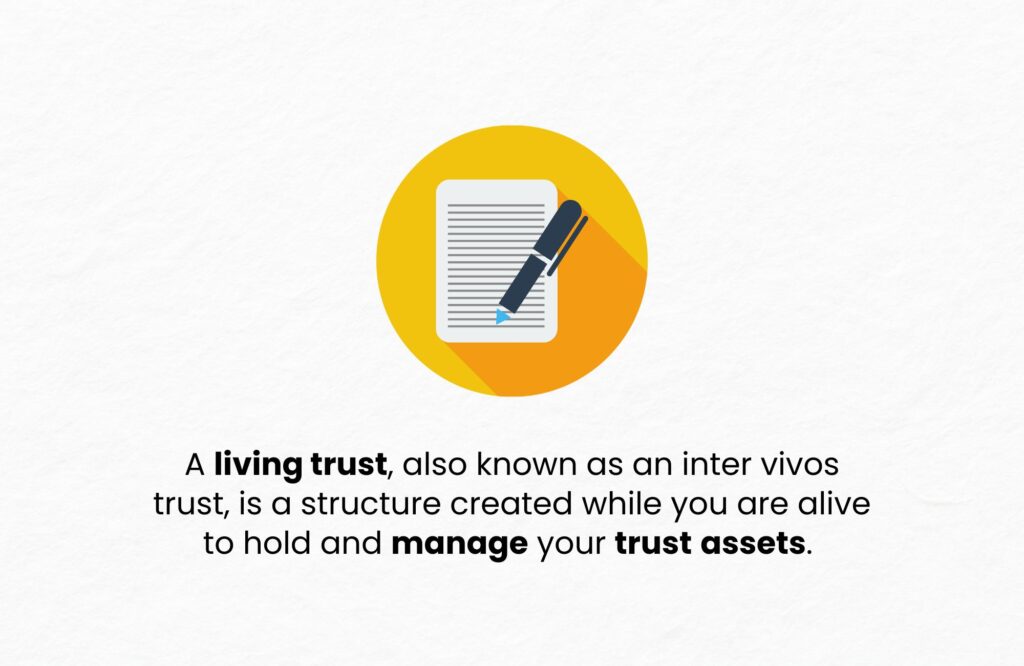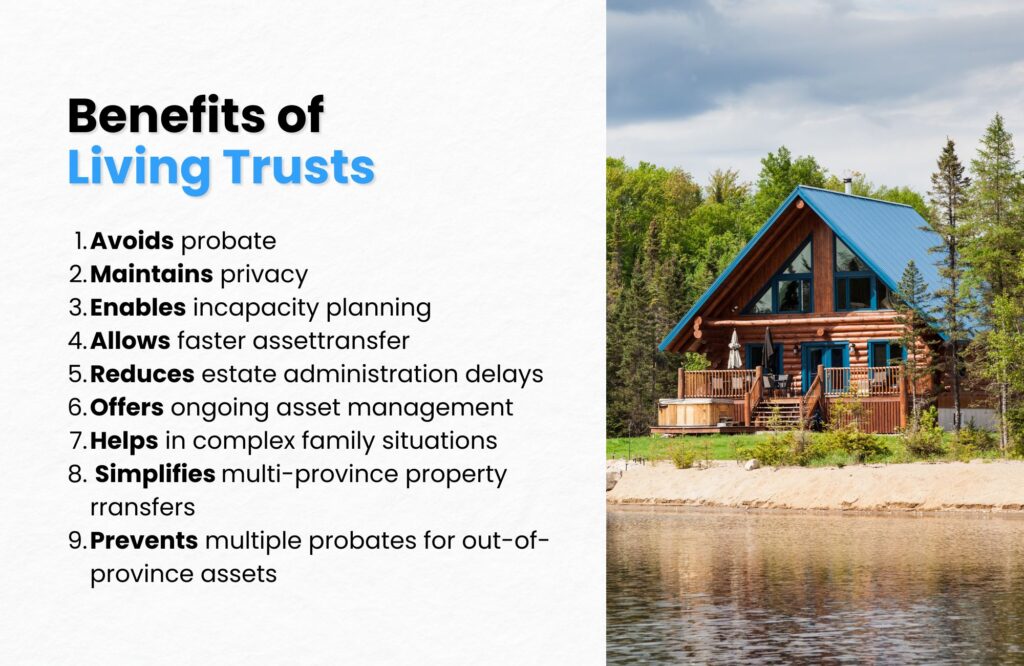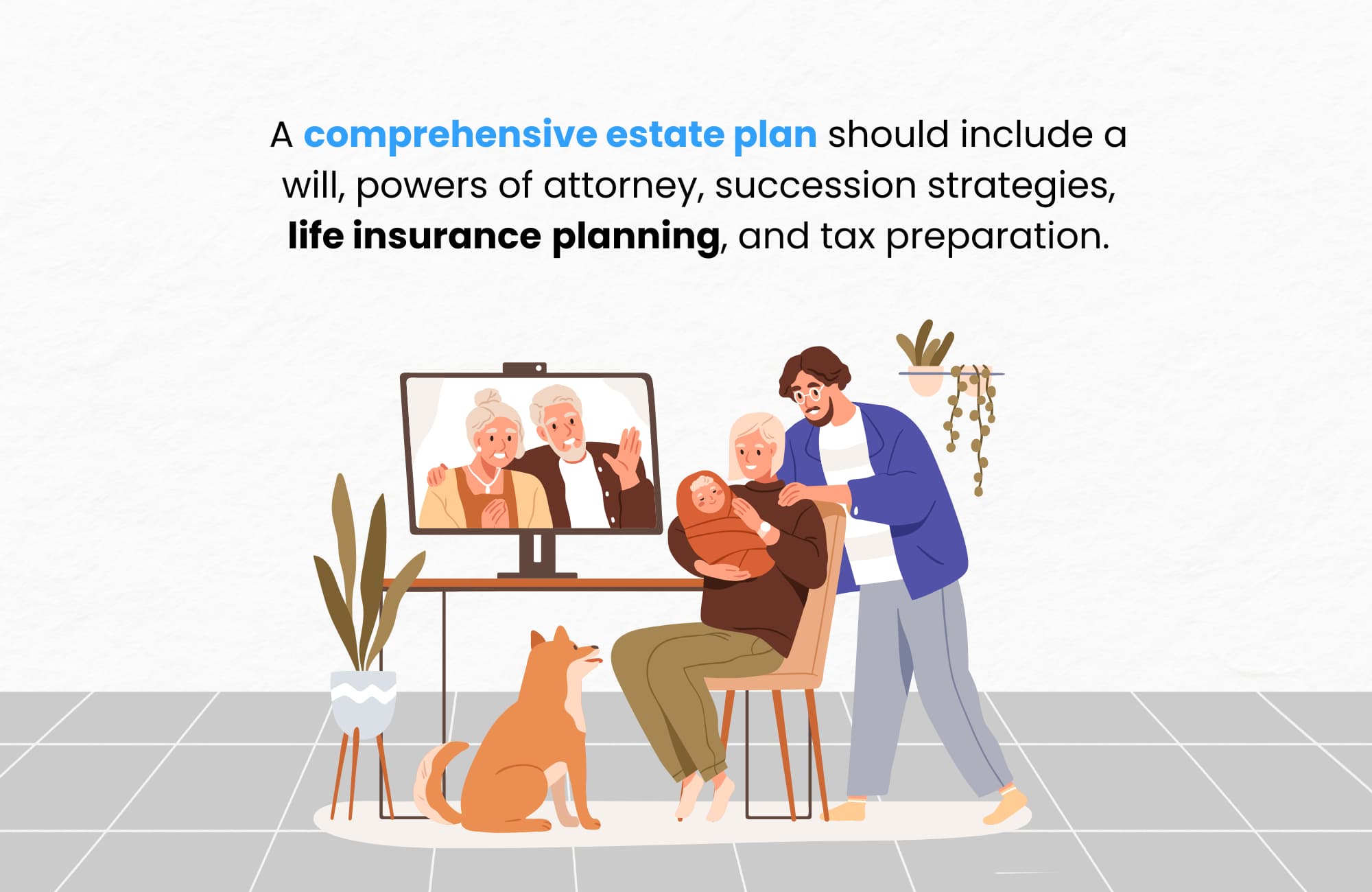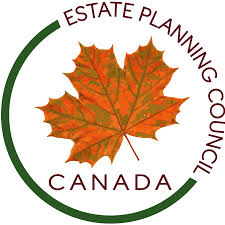Written by Ron Cooke, President & Founder of Strategic Wealth Protection Partners in Ontario, CEA®, Member of the Estate Planning Council Canada
Are living trusts a good idea?
Living trusts can be a good idea if you want to avoid probate, keep financial matters private, and have assets managed effectively during incapacity.
A living trust is a legal arrangement where a person transfers assets to a trust during their lifetime to be managed and distributed by a trustee. Living trusts help transfer assets faster than a will and may reduce estate administration costs.
However, they involve upfront legal fees and ongoing management. They don’t save taxes directly.
Living trusts work best for complex estates or privacy concerns. Whether or not a living trust is a good idea depends on your goals and assets. Keep reading for more details on who needs a living trust.

Key Takeaways:
- A trust should be part of a complete estate plan
- A living trust can help avoid probate fees and delays
- Trusts do not eliminate estate taxes or capital gains
- Revocable and irrevocable trusts serve different estate planning needs
- Trusts require ongoing compliance and tax reporting
What Are Living Trusts in Canada?
A living trust, also known as an inter vivos trust, is a structure created while you are alive to hold and manage your trust assets.
It is established through a formal trust document, which sets out who will benefit from the assets and under what terms. In Canada, the most common types are the revocable living trust, where the settlor retains control, and the irrevocable trust, which provides more permanence and potential tax planning opportunities.

Who Needs a Living Trust?
Not every estate requires a living trust, but it can be a powerful tool for certain families.
If you own multiple properties, want to provide for blended family members, or need to simplify wealth transfer, a trust may help. A financial advisor can review your overall estate plan and guide you on whether a living trust fits your goals.
Benefits of Living Trusts
- Avoids Probate: Assets in a living trust pass directly to beneficiaries without going through the probate court process. Avoiding the probate process can be beneficial as it is time consuming and can be costly
- Maintains Privacy: Trusts are private documents and do not become public like wills in probate.
- Enables Incapacity Planning: A trustee can manage the assets if the settlor becomes mentally incapable.
- Allows Faster Asset Transfer: Beneficiaries can receive trust assets without waiting for probate to conclude.
- Reduces Estate Administration Delays: Since probate is avoided, delays related to court filings and approvals are minimized.
- Offers Ongoing Asset Management: Assets in the trust can be actively managed by a trustee both during life and after death.
- Helps in Complex Family Situations: Trusts can be structured to control distributions in blended families or for vulnerable beneficiaries.
- Can Simplify Multi-Province Property Transfers: Holding property in multiple provinces can be easier to manage through one trust structure.
- Avoids Multiple Probates (for out-of-province assets): A trust can prevent separate probate processes in other provinces where real estate is held.

Disadvantages of Living Trusts
- High Setup Costs: Legal fees to draft and structure a trust are typically higher than for a will.
- Ongoing Legal and Accounting Fees: Trusts may require continued legal and tax advice to stay compliant.
- No Tax Savings: Living trusts do not reduce income tax or eliminate capital gains tax on death.
- Complex to Manage: Maintaining a trust involves legal formalities and proper recordkeeping.
- Not All Assets Fit Easily in a Living Trust: Certain assets, like registered accounts, cannot be transferred into a living trust.
- May Require Trust Tax Returns: In some cases, the trust must file its own tax return annually.
- Can Be Overkill for Simple Estates: For straightforward estates, a will may be more practical and cost-effective.
- No Protection from Creditors or Lawsuits: Assets in a revocable living trust are not shielded from creditors.
- Can Trigger Capital Gains on Transfer: Moving assets into the trust may result in a taxable disposition.
How Can I Set Up a Living Trust in Canada?
To set up a living trust, you must work with an estate attorney to draft a valid trust document.
Assets such as property, investments, and bank accounts are then transferred into the trust’s name. Once in place, the trustee manages the trust assets according to the rules you set out in the document.

What are the Types of Living Trusts in Canada?
- Revocable Living Trust – Flexible but rare in Canada, since the income is taxed back to the settlor.
- Irrevocable Living Trust – Permanent, used for tax freezes, protection, and long-term planning.
- Inter Vivos Trust – The broader category, created during life, under which both revocable and irrevocable trusts fall.
Taxation of Living Trusts in Canada
Trust Tax Filing Requirements
Trusts must file annual returns with the CRA and report income earned by the trust.
This means that a trust is treated like its own “mini taxpayer” in the eyes of the government. If the trust earns interest, dividends, or rental income, that income needs to be reported separately from your personal tax return. Setting up a trust can therefore add some ongoing accounting costs and paperwork, which is something to factor in when deciding if a trust makes sense.
Capital Gains Implications of Funding a Living Trust
When transferring assets into a trust, a deemed disposition may trigger capital gains immediately.
In simple terms, the CRA assumes you sold the asset at fair market value the moment you move it into the trust, even if no money changes hands. If your cottage, stocks, or investment property have gone up in value, you could owe tax on those gains right away. For people with highly appreciated assets, this can create a big upfront tax bill, so professional advice is critical before making a transfer.
Income Splitting and Attribution Rules
Attribution rules may limit income splitting within a family trust, especially when involving minor children.
While trusts can be powerful for shifting income to family members in lower tax brackets, the government has strict rules to prevent abuse. For example, if a trust pays income to your minor child, those amounts may be “attributed” back to you and taxed at your higher rate. This reduces the potential tax savings. The rules are complex, so whether a trust works for income splitting depends heavily on your family situation.
Taxation of Trust Income and Distributions
Trust income may be taxed within the trust or attributed to beneficiaries. The 21-year rule deems capital property sold every 21 years, potentially creating tax liabilities.
This means trusts can be flexible: you can either keep income inside the trust (where it may be taxed at high rates) or distribute it to beneficiaries (who may be taxed at their own, possibly lower, rates). However, you can’t defer taxes forever. Every 21 years, the CRA forces a “pretend sale” of trust assets, which can trigger a large tax bill if the assets have grown significantly in value. This pretend sale is called a deemed disposition. The government deems that your assets have been disposed of for tax purposed.
Families often plan around this milestone to avoid surprises.

Is a Living Trust Right for You?
Living trusts are not for everyone, but they can provide significant benefits in certain circumstances.
If your estate is large, complex, or involves multiple properties or blended families, a trust may be worth considering. Speaking with a financial expert ensures your plan minimizes estate taxes, maximizes tax deferral benefits, and preserves wealth for future generations.
A Living Trust Is Not an Estate Plan
It is important to remember that a living trust by itself does not make a complete estate plan.
A comprehensive estate plan should include a will, powers of attorney, succession strategies, Life Insurance planning, and tax preparation. Only when all pieces work together can your family be fully protected.

Common Questions
What are the disadvantages of a living trust in Canada?
They can be costly, complex, and do not eliminate estate taxes or income tax obligations. In some cases, the ongoing legal and accounting fees outweigh the benefits unless you have significant assets or complex family circumstances.
What is the biggest mistake parents make when setting up a trust fund?
The most common mistake is failing to clearly define distribution rules, which can cause disputes among children. Without clear instructions, trustees are left to interpret intentions, which can fuel resentment or even lead to legal battles.
When is a living trust better than a will in Canada?
A living trust is better when avoiding probate, managing assets across provinces, or providing control in blended families. It also ensures smoother management if you become incapacitated, since the trustee can step in without the delays of court involvement.
Discover the Benefits of a Living Trust in Ontario
Are you an Ontario resident considering a living trust as part of your estate planning?
At Strategic Wealth Protection Partners, we’re here to guide you through every step of the process with expert advice and personalized support. Begin your estate planning journey today with a Living Estate Plan Consultation from our experienced team.
Our mission at SWPP is to help you create an estate plan that secures your legacy, shields your assets from unnecessary taxation, and ensures your loved ones are cared for. By designing a living trust tailored to your goals, our experts will help you build a plan that truly reflects your values and priorities.
Take control of your future—start planning today!
Schedule a Living Estate Plan Consultation
Planning your legacy is about more than numbers—it’s about ensuring your family remembers you and your values are honoured for many years to come.
Estate planning and trusts can feel overwhelming, especially if it’s your first time. That’s why we’re here.
With our simple, 5-Step Living Estate Plan, we make the process easy, helping you create a comprehensive estate plan or trust that protects your assets from taxes and probate fees while preserving your legacy. Tools like The Final Word Journal capture your story, wishes, and essential details like accounts and end-of-life plans, ensuring your family has clarity and comfort.
Take the first step today—schedule a consultation call and give your family the ultimate gift: peace of mind and the assurance they were always your priority.
Read More
If you’re starting your estate planning process, you may find these articles helpful:
- Pros and Cons of Putting a House in a Trust in Canada
- How to Avoid Estate Tax in Canada in 2025
- Do Living Trusts Go Through Probate in Canada?
- How Does Taxation of Trusts Work in Canada?
About the Author
RON COOKE, PRESIDENT & FOUNDER OF STRATEGIC WEALTH PROTECTION PARTNERS

With over 30 years in financial services, I’ve seen the challenges families face when a loved one passes—lost assets, unnecessary taxes, and emotional stress. That’s why I created the Living Estate Plan, a comprehensive process to protect assets, eliminate estate and probate fees, and create legacies that are remembered for many years to come.
This plan ensures your family receives not just your wealth, but a meaningful reminder of your care and love. Tools like The Final Word Journal capture your story, wishes, and essential details, offering clarity and comfort during difficult times.
Your final gift should be more than money—it should be peace of mind, cherished memories, and an organized estate.
Schedule a Call
Schedule a 30-minute consultation call with Strategic Wealth Protection Partners.
Click HERE to schedule a consultation.









